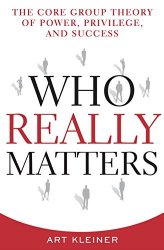Summary: Jack Welch-style management can be an effective antidote to complacent bureaucracies. Unfortunately it can also easily take the warmth out of a business and leave fractured and isolated Core Group with little ability to inspire commitment, foster quality, and sustain business success. The way to apply Welch-style management successfully is to be “intensely devoted to cultivating their people at the same time they prune them.”

Who Really Matters (Amazon, Goodreads, Powells) puts forth the theory that central to every organization is a Core Group of people who really matter.
This post is part of a series summarizing the book and covers Chapter 10: Welchism. You may want to start with the introduction.
Chapter 10: Welchism
This chapter explores the effects of Jack Welch-style management on organizations though the Core Group theory lens.
In 1981 when Jack Welch became CEO of General Electric, the company was floundering. It’s once productive Core Group had evolved into a complacent bureaucracy. Welch turned the company around by changing who was in the Core Group and how long they stayed there. This approach has become one of the most copied management practices, which Kleiner calls “Welchism” and defines as:
The deliberate streamlining of the organization by defining the core group — from a large body of employees with lifelong membership to a very small group of people whose membership is permanently insecure. (p. 90)
Welch’s primary mechanism for realignment was the vitality curve. Each year everyone was evaluated and ranked according to two criteria: Do they get results?” and “Do they match our values?” Values in this case meant the values Welch himself embodied: hard-driven, brash, energetic. The top 20% were A Players, the middle 70% B Players, and the lowest 10% C Players. A Players received the best rewards: raises, promotions and stock options. B Players received modest rewards. C players were laid off.
Under Welch, being an A Player got you into the Core Group, but your position there was never guaranteed and would be reevaluated each year and you had to work to stay there.
In interviewing folks who were at GE during this time, Kleiner found that the most disenfranchised by Welch’s system were the B Players. Even when they had done good work and been diligent employees, because they couldn’t break into the ranks of the top 20%, they felt they were taken for granted and never fully recognized for their contributions. One person said:
You’re either on the team or off the team. If you’re off the team, you may be able to stay if you do your job, but you’ll never feel like anybody really wants you here. (p. 92)
Having a large portion of your organization who feels disengaged (not “on the team”) reduces the efficacy of the entire organization. By focusing only on ranked performance, organizations squeeze out many of the hard to measure human qualities that are essential for success. As Kleiner says:
The warmth…goes out of the business. What’s left is a fractured and isolated Core Group that (all to often) loses its ability to inspire commitment, foster quality, and sustain business success. (p. 94)
So, while Welchism can be an important antidote to entrenched bureaucracy, it’s important not to “throw the human creativity out with the bureaucracy bathwater.” And creativity needs space to fail, to be messy and fuzzy. For Welchism to be successful, it can’t be simplified to “identify the weakest 20% and lay them off.” That approach is costly, ineffectual, and habit-forming.
Rather, organizations wanting to apply Welch-style management successfully need to be “intensely devoted to cultivating their people at the same time they prune them.” (p. 95) They need to demonstrate they value individuals and their creativity by investing in their development and success. This gives people the best chance of being seen and recognized as a “A Player” and helps maintain the “warmth” of the organization.
What’s Next?
Stay tuned for our next post in this series, a summary of Chapter 11: The CEOs choices, which explores the factors that constrain your influence as CEO and how best to leverage that influence.
Citations
Kleiner, Art. Who Really Matters: The Core Group Theory of Power, Privilege, and Success. 1st ed. New York: Currency/Doubleday, 2003.
This post is part of our Book Summary series in which we share summaries of books about leadership, governance, and community building. To discuss the book, leave a comment below or join our Goodreads group.


0 Comments